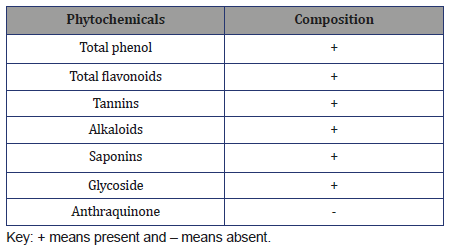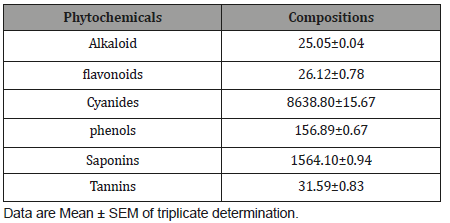Authored by Alawode Rahmatallah Adenike*,
Abstract
Background: This study was carried out to investigate proximate composition, phytochemical profile and antimicrobial activity of the aqueous extract of Cordylia pinnata.
Methods: Phytochemical and proximate composition was determined using standard procedures. Antimicrobial test against S. aureus, E. coli, and S. typhi was investigated using agar diffusion method.
Results: Cordylia pinnata contains phenol, flavonoids, tannins, alkaloids, saponins and glycosides. Quantitatively, Cordylia pinnata contains alkaloids (25.05±0.04 mg/100g), flavonoids (26.12±0.78 mg/100g), cyanide (8638.80±15.67 mg/100g), phenols (156.89±0.67 mg/100g), saponins (1564.10±0.94 mg/100g), tannins (31.59±0.83 mg/100g). The proximate compositions show that Cordylia pinnata contains moisture (3.46±0.32%), ash (7.42±0.11 %), proteins (13.13±0.21 %), fibers (13.5±0.12 %), Carbohydrate (57.57±0.34 %). The extract was more sensitive to Salmonella typhi with inhibition zone in the range from 23.00 ±0.67 mm to 30.00±0.67mm. Zone of inhibition of E. coli ranged from 18.50±0.04mm and 27.00±0.56mm. The extract was sensitive to Staphylococcus aureus only at the concentrations of 80mg/mL (20.00±0.35mm) and 100mg/mL (26.00±0.89mm).
Conclusion: Aqueous extract of Cordylia pinnata contains significant amounts of nutrients which if consumed in sufficient amount could contribute greatly towards meeting human nutritional requirement for normal growth and adequate protection against diseases arising from malnutrition. The extract contains appreciable amounts of phytochemicals which might have contributed to its antimicrobial activities.
Keywords:Cordylia pinnata; Phytochemicals; Proximate; Antimicrobial
Introduction
Infectious diseases are responsible for an overwhelming number of deaths and morbidity worldwide [1]. In tropical regions of the world, in particular, developing countries like Nigeria, poor health is prevalent and diseases such as malaria, meningitis, pneumonia, tuberculosis and gastrointestinal infections strongly persist. From ancient times, different parts of medicinal plants have been used to cure specific ailments [2].
Recently, a gradual revival of interest in the use of medicinal plants in developing countries was rekindled because herbal medicines have been reported to be safe and without any adverse side effect especially when compared with synthetic drugs [3]. They are still actively used against some infections as primary care before seeking conventional treatment at hospitals [2].
Medicinal herbs are a source of chemical compounds such as alkaloids, glycosides, saponin, oleoresins, sesqueterpine, lactones and oils [4]. These biologically active ingredients are used for the prophylactic purposes and for the different infectious diseases [5,6]. Due to the presence of medicative properties, medicinal plants have been used in wide area of the world. Many diseases like malaria, trypanosomiasis, oxidative stress, epilepsy, diarrhea, dysentery, fungal and bacterial infections have been treated by folklore medicines and have received substantial scientific validation [7-11].
Cordyla pinnata Lepr. ex A. Rich. commonly known as Bush mango. It’s a flowering plant belonging to Fabaceae family. It is native to Western Tropical Africa from Senegal to Nigeria. The plant is harvested from the wild and used locally to supply wood, food and medicine [11]. In African traditional medicine, the leaves, root and bark decoctions of Cordyla pinnata are used as tonic, water purifier, diuretic, oxytocic, cholagogue, aphrodisiac, and to treat, diarrhoea, gastro-intestinal discomfort, worms, lumbago, syphilis and schistosomiasis [12].
Due to the paucity of information on phytochemistry and proximate composition of this plant, this study was necessitated to investigate the proximate compositions, antimicrobial activity and bioactive compounds in the leaf of Cordyla pinnata which may provide baseline information for their subsequent utilization in supplementing nutritional requirements and for use as antimicrobial herb.
Materials and Methods
Sample collection and extraction
Fresh leaves sample of Cordylia pinnata was collected in March 2019 at Mokwa Nigeria. The leaves were thoroughly washed under running tap water to remove all contaminants after which they were cut into pieces, dried for 2 wk (37oC) and finally grounded using a grinder mill. A 50 g of the plant material was macerated with 300 mL of distilled water for 24 hrs and the resulting extract was filtered and concentrated using water bath.
Qualitative and Quantitative screening for secondary metabolites
The plant extract was analyzed for the presence of some secondary metabolite including alkaloids, terpenes, tannins, saponins, phenols, steroids, phlobatannins and flavonoids using standard procedures [13-15]. Quantitative analysis was conducted for flavonoid, alkaloids, total phenol, tannin and saponins using standard procedures [16].
Proximate analysis
The proximate compositions of Cordylia pinnata leaf including; crude proteins, crude fiber, moisture content, ash content, crude fat and carbohydrate were determined using standard procedures [16].
Antimicrobial activity
The antimicrobial activities of the fractions were evaluated at concentrations of 20, 30, and 40 mg/ml using agar well diffusion method as described by Yusuf, et al. [17] and Tsado, et al. [18]. The antibacterial activity was expressed as the mean zone of inhibition diameters (mm) produced by the plant fractions.
Statistical analysis
Values were analyzed using statistical package for social science (SPSS) version 21 and presented as means ± SE of the mean. Comparisons between different groups were carried out by oneway analysis of variance (ANOVA) followed by Duncan’s Multiple Range Test (DMRT). The level of significance was set at P < 0.05.
Conclusion and Recommendations
" class="head-link">Conclusion and Recommendations
Qualitative phytochemicals
The qualitative phytochemical compositions of Cordylia pinnata are presented in Table 1. Cordylia pinnata contains Total phenol, total flavonoids, tannins, alkaloids, saponins and glycosides. Anthraquinone was however not present.
Quantitative phytochemicals
The quantitative phytochemical compositions of Cordylia pinnata are presented in Table 2. Cordylia pinnata contains alkaloids (25.05±0.04 mg/100g), flavonoids (26.12±0.78 mg/100g), cyanide (8638.80±15.67 mg/100g), phenols (156.89±0.67 mg/100g), saponins (1564.10±0.94 mg/100g), tannins (31.59±0.83 mg/100g).
Proximate composition
The proximate compositions of Cordylia pinnata is presented in Table 3. Cordylia pinnata contains moisture (3.46±0.32%), ash (7.42±0.11 %), proteins (13.13±0.21 %), fibers (13.5±0.12 %), Carbohydrate (57.57±0.34 %).
Antimicrobial activities
The Zones of inhibition of Salmonella typhi, Staphylococcus aureus and E. coli by aqueous extract of Cordylia pinnata is presented in Table 4. The zones of inhibition of Salmonella typhi, Staphylococcus aureus and E. coli demonstrated by the extract increased with increasing concentration. The extract was more sensitive to Salmonella typhi with inhibition zone in the range from 23.00 ±0.67 mm to 30.00±0.67 mm. zone of inhibition of E. coli ranged from 18.50±0.04 mm and 27.00±0.56 mm. The extract was sensitive to Staphylococcus aureus only at the concentrations of 80 mg/mL (20.00±0.35 mm) and 100 mg/mL (26.00±0.89 mm) (Table 1-4).
Table 1: Qualitative phytochemical composition of Cordylia pinnata.

Table 2: Quantitative phytochemical composition of Cordylia pinnata.

Table 3: Proximate composition of Cordylia pinnata.

Table 4: Antimicrobial activities of crude aqueous leaf extract of Cordylia pinnata.

Discussion
The result of the phytochemical screening is as shown in Table 1. These phytoconstituents are secondary metabolites, which are biologically active and may be applied in nutrition and as pharmacologically active agents [19]. The presence of glycoside may support against cardiovascular disorder since cardiac glycosides are clinically used in the treatment of congestive heart failure and as anti-arrhythmic agents due to their strong inhibitory activity toward the ubiquitous cell surface enzyme Na+/K+-ATPase [20]. In order to formulate, produce and market quality diets it is necessary to gain information about substance classes that contribute to the energy content and special compounds, which influence digestibility [21]. Each medicinal plant species has its own nutrient composition besides having pharmacologically important phytochemicals.
Nutrients are essential for the physiological functions of human body. Such nutrients and biochemicals like carbohydrates, fats and proteins play an important role in satisfying human needs for energy and life processes [22]. Hence, the proximate analysis was investigated in order to ascertain the nutritive importance of the sample for possible human consumption as well as in livestock feed meal formulation. The moisture content was 3.46±0.32%, which allow for improved activity of watersoluble enzymes and coenzymes needed for metabolic activities. Moisture content is among the most vital and mostly used measurement in the processing, preservation and storage of food [23]. Thus, this low moisture content implies that the product possess high shelf life. The dry matter component was 96.54±2.48%, which was the summed total of ash (7.42±0.11 %), proteins (13.13±0.21 %), fibers (13.5±0.12 %) and Carbohydrate (57.57±0.34 %). The protein content of the plant was found to be 13.13±0.21 %, which shows that the plant can serve as a source of protein considering the level of protein deficiency in the society today. Its intake can contribute to the formation of hormones, which controls a variety of body functions such as growth, repair and maintenance. The crude fibre was 13.5±0.12 %. In the intestinal tract, fiber resists being broken down by enzymes; although, part of it may be metabolized by bacteria in the lower gut [21]. Fiber is characterized by low or no nutritional value, but because of its effect on the digestive system, it is thought to help with such problems as diabetes and high levels of blood cholesterol [24, 25]. This high crude fiber might aid in combating gastrointestinal disorder, since, individuals with high intakes of dietary fiber appear to be at significantly lower risk for developing coronary heart disease, stroke, hypertension, diabetes, obesity and certain gastrointestinal diseases [26]. The carbohydrate is categorized as the nitrogen free extract (extract), which comprises of the easily digestible carbohydrates such as sugar, starch and organic acids [21]. The amount of carbohydrate herein was 57.57±0.34 %, which conferred on the plant, significant roles to human health. This is because, apart from the supply of energy, carbohydrates are also needed in numerous biochemical reactions not directly concerned with energy metabolism as earlier reported by Bhattacharjee et al. [27].
Antimicrobial sensitivity testing was carried out in vitro using agar-well diffusion method against Salmonella typhi, Staphylococcus aureus and E. coli. The aqueous extract of Cordylia pinnata had varying degree of antimicrobial activity against the test organisms. On the basis of the results the extract demonstrated to be more active on E. coli and least active on Staphylococcus aureus. This was not a surprise since previous studies [28] have reported that generally plant extracts are usually more active against Gram-positive bacteria than Gram-negative bacteria, and the susceptibility may be due to structural differences in the cell wall of these classes of bacteria [29]. Cells of Gram-negative bacteria are surrounded by an additional outer membrane, which provide them with a hydrophilic surface that functions as a permeability barrier for many substances including natural compounds [30]. It was also observed that increase in the concentration of all the extract yielded their corresponding increase in the zones of inhibition. This linear relationship between the concentrations of extracts and zones of inhibition could be that the extracts were able to diffuse into the inoculated nutrient agar [31-33]. The ability of the extract to inhibit the growth Staphylococcus aureus and E. coli explains why it is used in folk medicine for the treatment of infectious diseases. However, despite the higher zone of inhibition demonstrated by the plant extract the zone of inhibitions was lower on all test organism compare to zone of inhibitions demonstrated by standard antibiotics drug (ciprofloxacin) used in this study.
Conclusion
Aqueous extract of Cordylia pinnata contains significant amounts of nutrients which if consumed in sufficient amount could contribute greatly towards meeting human nutritional requirement for normal growth and adequate protection against diseases arising from malnutrition. The extract contains appreciable amounts of phytochemicals which might have contributed to its antimicrobial activities.
To read more about this article...Open access Journal of Biology & Life Sciences
Please follow the URL to access more information about this article
To know more about our Journals...Iris Publishers





No comments:
Post a Comment